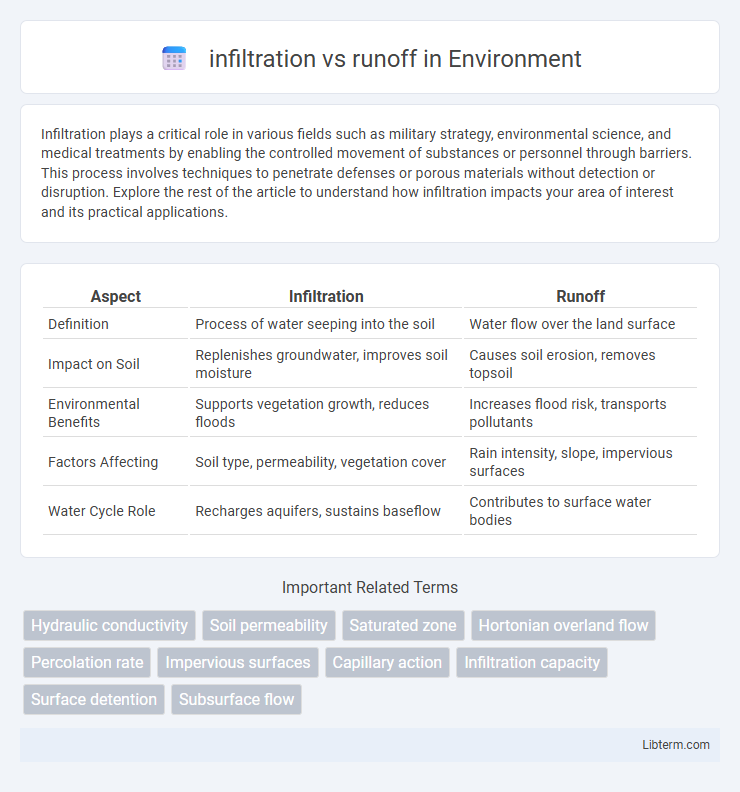Infiltration plays a critical role in various fields such as military strategy, environmental science, and medical treatments by enabling the controlled movement of substances or personnel through barriers. This process involves techniques to penetrate defenses or porous materials without detection or disruption. Explore the rest of the article to understand how infiltration impacts your area of interest and its practical applications.
Table of Comparison
| Aspect | Infiltration | Runoff |
|---|---|---|
| Definition | Process of water seeping into the soil | Water flow over the land surface |
| Impact on Soil | Replenishes groundwater, improves soil moisture | Causes soil erosion, removes topsoil |
| Environmental Benefits | Supports vegetation growth, reduces floods | Increases flood risk, transports pollutants |
| Factors Affecting | Soil type, permeability, vegetation cover | Rain intensity, slope, impervious surfaces |
| Water Cycle Role | Recharges aquifers, sustains baseflow | Contributes to surface water bodies |
Introduction to Infiltration and Runoff
Infiltration refers to the process where water from precipitation penetrates the soil surface and moves into the subsurface layers, influencing groundwater recharge and soil moisture levels. Runoff occurs when excess water flows over the land surface due to saturation, impervious surfaces, or intense rainfall exceeding infiltration capacity, leading to increased erosion and potential flooding. Understanding the balance between infiltration and runoff is critical for managing water resources, controlling erosion, and designing effective stormwater management systems.
Defining Infiltration
Infiltration refers to the process by which water on the ground surface enters the soil, replenishing groundwater and supporting plant growth. It is influenced by soil type, vegetation cover, and soil moisture content, determining how much water penetrates versus becoming surface runoff. Efficient infiltration reduces runoff, minimizing erosion and flooding risks while enhancing water availability for ecosystems.
Understanding Runoff
Runoff is the portion of precipitation that flows over land surfaces toward rivers, lakes, or oceans when infiltration capacity is exceeded. This process significantly contributes to surface water accumulation and can lead to soil erosion, flooding, and water pollution. Understanding runoff dynamics is crucial for effective stormwater management, flood control, and designing sustainable urban drainage systems.
Factors Affecting Infiltration
Soil texture, land slope, and vegetation cover critically affect infiltration rates, as sandy soils promote faster infiltration compared to clayey soils, while steep slopes enhance runoff by reducing soil absorption capacity. Vegetation improves infiltration by increasing soil porosity and organic matter, which facilitates water movement into the ground, thus reducing surface runoff. Soil compaction and impervious surfaces significantly hinder infiltration, leading to higher runoff and increased erosion risks.
Factors Influencing Runoff
Runoff is primarily influenced by factors such as soil type, vegetation cover, rainfall intensity, and land slope. Impermeable soils, sparse vegetation, intense rainfall, and steep slopes increase surface runoff by reducing infiltration rates. Urbanization with impervious surfaces significantly accelerates runoff, leading to higher flood risks and reduced groundwater recharge.
The Hydrologic Cycle: Infiltration vs Runoff
In the hydrologic cycle, infiltration refers to the process where water soaks into the soil, replenishing groundwater and supporting plant growth, while runoff occurs when excess water flows over the land surface, often leading to erosion and water pollution. Soil type, vegetation cover, and land slope significantly influence the balance between infiltration and runoff. Understanding this dynamic is crucial for managing water resources, preventing floods, and maintaining ecosystem health.
Environmental Impacts of Infiltration
Infiltration enhances groundwater recharge, reducing surface runoff and mitigating erosion, which preserves soil quality and aquatic habitats. It filters pollutants through the soil, improving water quality by trapping sediments, nutrients, and pathogens before they reach water bodies. Effective infiltration decreases flood risks and minimizes the transport of contaminants, supporting sustainable watershed management and ecosystem health.
Consequences of Excess Runoff
Excess runoff leads to soil erosion, nutrient depletion, and increased sedimentation in water bodies, which degrades aquatic ecosystems. This surplus water contributes to flooding, property damage, and infrastructure strain, causing costly repairs and disruption. Moreover, contaminated runoff transports pollutants such as pesticides, oils, and heavy metals into rivers and lakes, degrading water quality and threatening public health.
Mitigation Strategies for Runoff Management
Mitigation strategies for runoff management emphasize enhancing infiltration through green infrastructure such as permeable pavements, rain gardens, and bioswales to reduce surface water flow and promote groundwater recharge. Vegetative buffers and soil amendments increase soil permeability and capture pollutants, improving water quality and reducing peak runoff volumes. Stormwater harvesting systems also help manage excess runoff by collecting and storing water for reuse, mitigating flooding risks and conserving resources.
Comparing Infiltration and Runoff: Key Differences
Infiltration refers to the process where water permeates the soil, facilitating groundwater recharge and reducing surface water accumulation. Runoff occurs when excess water flows over land surfaces, often leading to erosion and increased flood risk. Key differences include infiltration's role in sustainable water management and runoff's contribution to potential water pollution and soil degradation.
infiltration Infographic

 libterm.com
libterm.com